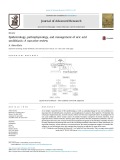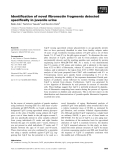
Urinary pH
-
Crassocephalum crepidioides is a medicinal plant used in west and central Africa, not only as leguminous crop, but also to treat high blood pressure in particular. The objective of this work was to evaluate the diuretic activity of aqueous leaves extract of C. crepidioides in the treatment of high blood pressure as claimed by traditional healers. Rats both male and female were used to evaluate the diuretic activity. C. crepidioides was administered to rats at 25, 50, 75, 100 and 125mg/kg.
 19p
19p  quenchua2
quenchua2
 15-12-2019
15-12-2019
 19
19
 2
2
 Download
Download
-
The major purpose of our study is to evaluate the impact of cinnamon on long term prediabetic induced renal alterations caused by intraperitonial induction of neonatal streptozotocin (nSTZ). Two-day old male Sprague Dawley (SD) rat pups (n=30) received a single intra peritoneal injection of STZ (90 mg/kg bw) dissolved in 0.1M citrate buffer, pH 4.5 while Control pups (n=8) received the vehicle alone. All rats were maintained on an AIN-93G/M diet in individual cages and a subset of pre-diabetic animals received 3% cinnamon in the AIN-93 diet.
 8p
8p  nguaconbaynhay1
nguaconbaynhay1
 04-12-2019
04-12-2019
 30
30
 0
0
 Download
Download
-
An in-depth comprehension of the epidemiology as well as pathophysiology of uric acid urolithiasis is important for the identification, treatment, and prophylaxis of calculi in these patients. Persistently low urinary pH, hyperuricosuria, and low urinary volume are the most important factors in pathogenesis of uric acid urolithiasis. Other various causes of calculus formation comprises of chronic diarrhea, renal hyperuricosuria, insulin resistance, primary gout, extra purine in the diet, neoplastic syndromes, and congenital hyperuricemia.
 15p
15p  trinhthamhodang1
trinhthamhodang1
 14-11-2019
14-11-2019
 18
18
 1
1
 Download
Download
-
To investigate rate, characteristics of acid-base disturbances in patients with chronic kidney disease stage 4, 5 who were diagnosed for the first time. Subjects and methods: 182 patients with chronic kidney disease stage 4, 5 due to some causes without alkalization or replacement therapy within a month. Assessment of acid-base disturbances based on results of arterial blood gas test according to the criteria of Berend K, which include pH, HCO3 - and PaCO2.
 7p
7p  caygaolon
caygaolon
 01-11-2019
01-11-2019
 18
18
 0
0
 Download
Download
-
Báo cáo khoa học: Identification of novel fibronectin fragments detected specifically in juvenile urine
Ugl-Y (young age-related urinary glycoprotein) is an age-specific protein that we have previously identified in urine from healthy subjects under 18 years of age. Isoelectric focusing analysis of Ugl-Y gives a set of three bands, Y1, Y2 and Y3, in the pH region around 3.
 9p
9p  galaxyss3
galaxyss3
 21-03-2013
21-03-2013
 43
43
 3
3
 Download
Download
-
Costs of pre-biopsy tests, biopsy costs (including biopsy kit, ultrasound time, procedure cost, pathology cost, drug cost, hospital bed cost) were obtained from the Hospital Costs Unit Hospital de Carabineros de Chile and Hospital DIPRECA and based on Public Health Service (PHS) list prices in the case of Public Health Patients (FONASA) and Private Health Insurance (PHI) list prices in the case of Private Patients (Isapres). Costs for CPC detection were obtained from the Instituto de Bio-Oncology Costs Unit.
 174p
174p  ti_du_hoang
ti_du_hoang
 10-08-2012
10-08-2012
 133
133
 2
2
 Download
Download
-
Approach to the Patient: Hyperchloremic Metabolic Acidoses In diarrhea, stools contain a higher [HCO3–] and decomposed HCO3– than plasma so that metabolic acidosis develops along with volume depletion. Instead of an acid urine pH (as anticipated with systemic acidosis), urine pH is usually around 6 because metabolic acidosis and hypokalemia increase renal synthesis and excretion of NH4+, thus providing a urinary buffer that increases urine pH. Metabolic acidosis due to gastrointestinal losses with a high urine pH can be differentiated from RTA (Chap.
 5p
5p  ongxaemnumber1
ongxaemnumber1
 29-11-2010
29-11-2010
 83
83
 2
2
 Download
Download
-
Isolated microscopic hematuria can be a manifestation of glomerular diseases. The RBCs of glomerular origin are often dysmorphic when examined by phase-contrast microscopy. Irregular shapes of RBCs may also occur due to pH and osmolarity changes produced along the distal nephron. There is, however, significant observer variability in detecting dysmorphic RBCs. The most common etiologies of isolated glomerular hematuria are IgA nephropathy, hereditary nephritis, and thin basement membrane disease. IgA nephropathy and hereditary nephritis can lead to episodic gross hematuria.
 5p
5p  ongxaemnumber1
ongxaemnumber1
 29-11-2010
29-11-2010
 73
73
 2
2
 Download
Download
CHỦ ĐỀ BẠN MUỐN TÌM




















